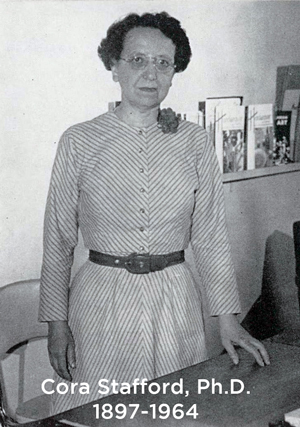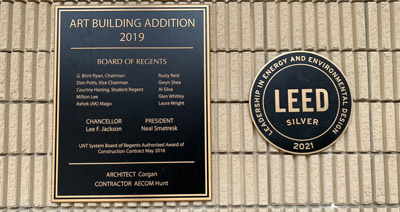CVAD History

History of the College
Art has been a vital part of UNT since it was first taught in 1893-1894, only a few years after the university was founded in 1890.
 Cora Stafford, an imaginative leader who served on the faculty and as director for 35 years before
retiring in 1964, played a major role in guiding the art program to its current reputation.
Determined to keep the program aligned with new ideas, she hired young innovators
on the faculty. These included James Prestini and György Kepes, early proponents of the Bauhaus system in the U.S., endeavoring to relate a new
design approach to the world of technology and craft. Also on the faculty were Carlos Mérida, the internationally known Guatemalan painter and muralist, and Octavio Medellín, the celebrated Mexican sculptor and painter. Students included Ray Gough, a noted interior designer and UNT professor, and O'Neil Ford, one of Texas' most
famous architects.
Cora Stafford, an imaginative leader who served on the faculty and as director for 35 years before
retiring in 1964, played a major role in guiding the art program to its current reputation.
Determined to keep the program aligned with new ideas, she hired young innovators
on the faculty. These included James Prestini and György Kepes, early proponents of the Bauhaus system in the U.S., endeavoring to relate a new
design approach to the world of technology and craft. Also on the faculty were Carlos Mérida, the internationally known Guatemalan painter and muralist, and Octavio Medellín, the celebrated Mexican sculptor and painter. Students included Ray Gough, a noted interior designer and UNT professor, and O'Neil Ford, one of Texas' most
famous architects.
Master’s degrees were initiated in the 1930s, and the first M.S. degree in art was awarded in 1937 to Ann Bookman Williams, a long-time art teacher in the campus demonstration school. UNT's modern art program has been one of continual growth. After World War II, professional programs in advertising art, fashion design and interior design supplemented traditional studio and art education programs. Following an extensive study of the arts in Texas by the Texas Higher Education Coordinating Board in the 1960s, UNT was designated as a major visual arts program in the state and was approved to offer the B.F.A., M.F.A. and Ph.D. degrees beginning in 1971. With the Southwest's demographic population shift in the late 1970s and early 1980s, enrollment increased dramatically. At the same time, the department's comprehensive art programs were being recognized for their quality.
 By the mid-1980s, to meet the future challenges, the Department of Art faculty began
discussing the possibility of reclassification as a separate school from the College
of Arts and Sciences. An arts model for this already existed on campus in UNT’s world-renowned
College of Music. A School of Visual Arts Advisory Board was formed with the assistance
of Dallas businessman Raymond D. Nasher, Kimbell Art Museum Director Ted Pillsbury, and members of the art and education community. That vision became reality in 1992 when the Texas Higher Education Coordinating
Board reclassified the Department of Art as the School of Visual Arts, effective in the 1993-94 academic year. In 2007, yet another formal stage of growth
in the school and university was recognized when SOVA became the College of Visual Arts and Design. Today, CVAD is one of the nation's largest and most comprehensive visual arts programs,
with more than 2,200 students enrolled.
By the mid-1980s, to meet the future challenges, the Department of Art faculty began
discussing the possibility of reclassification as a separate school from the College
of Arts and Sciences. An arts model for this already existed on campus in UNT’s world-renowned
College of Music. A School of Visual Arts Advisory Board was formed with the assistance
of Dallas businessman Raymond D. Nasher, Kimbell Art Museum Director Ted Pillsbury, and members of the art and education community. That vision became reality in 1992 when the Texas Higher Education Coordinating
Board reclassified the Department of Art as the School of Visual Arts, effective in the 1993-94 academic year. In 2007, yet another formal stage of growth
in the school and university was recognized when SOVA became the College of Visual Arts and Design. Today, CVAD is one of the nation's largest and most comprehensive visual arts programs,
with more than 2,200 students enrolled.
The 21st century has brought significant changes to the population and cultural landscape of the Dallas-Fort Worth region. The Dallas Arts District, the nation’s newest and largest, is complemented by the Museum District in Fort Worth. The Dragon Street, Deep Ellum and Bishop Arts Districts in Dallas blossom with commercial galleries, many of which are directed by and/or feature CVAD graduates. The Dallas and Fort Worth art and design communities provide students with valuable resources and expanded learning opportunities. Advertising, fashion, interior design businesses, product design, and retail establishments, as well as a wide variety of K-12 educational environments and government and non-governmental agencies, provide partnership opportunities. CVAD graduates play leadership roles in museums, design companies and education agencies throughout the area.
CVAD’s academic programs are supported by research institutes, including the Onstead Institute, the Print Research Institute of North Texas, P.R.I.N.T. Press, the Texas Fashion Collection, the Design Research Collaborative in Dallas, and the Contemporary Arab and Muslim Cultural Studies Institute, as well as an extensive visiting artist/scholar program. The college now operates three galleries: the CVAD Gallery, the Cora Stafford Gallery and the Paul Voertman Gallery. The Institute for the Advancement of the Arts, Art in Public Places Program and UNT on the Square exhibition and performance facility enhance these opportunities.
 The UNT Art Building, home to the College of Visual Arts and Design, serves as a prominent
gateway to the University of North Texas campus, occupying a significant edge of the
campus. Previously spread across eight buildings throughout the campus, the expansion
and renovation of the existing building, completed in 2019, unites 15 diverse programs
under one roof. The seamless consolidation of these programs encourages interdisciplinary
collaboration and connects the college to the larger DFW arts community through both
interior and exterior transparencies.
The UNT Art Building, home to the College of Visual Arts and Design, serves as a prominent
gateway to the University of North Texas campus, occupying a significant edge of the
campus. Previously spread across eight buildings throughout the campus, the expansion
and renovation of the existing building, completed in 2019, unites 15 diverse programs
under one roof. The seamless consolidation of these programs encourages interdisciplinary
collaboration and connects the college to the larger DFW arts community through both
interior and exterior transparencies.
The new addition honors the existing campus architecture while creating a modern face for the community. A large gallery space on the east corner of the ground floor features the artwork of students, alumni, and the broader Denton community. Prominent light monitors on the fourth floor create an iconic façade while maximizing natural light for painting and drawing studios. Student display units are spread throughout the building to showcase student work from conceptualization through the creation process, while enlarged, naturally-lit corridors serve as critique spaces. Spaces for making, discussing, and viewing were connected through merged studio spaces, large glass walls, and neutral materials, showcasing both the process and the final product.
Read more about our new building designed by Machado Silvetti, explore our degrees/programs of study and how to pursue your future in art and design at CVAD!